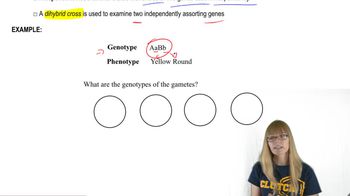Table of contents
- 1. Introduction to Genetics51m
- 2. Mendel's Laws of Inheritance3h 37m
- 3. Extensions to Mendelian Inheritance2h 41m
- 4. Genetic Mapping and Linkage2h 28m
- 5. Genetics of Bacteria and Viruses1h 21m
- 6. Chromosomal Variation1h 48m
- 7. DNA and Chromosome Structure56m
- 8. DNA Replication1h 10m
- 9. Mitosis and Meiosis1h 34m
- 10. Transcription1h 0m
- 11. Translation58m
- 12. Gene Regulation in Prokaryotes1h 19m
- 13. Gene Regulation in Eukaryotes44m
- 14. Genetic Control of Development44m
- 15. Genomes and Genomics1h 50m
- 16. Transposable Elements47m
- 17. Mutation, Repair, and Recombination1h 6m
- 18. Molecular Genetic Tools19m
- 19. Cancer Genetics29m
- 20. Quantitative Genetics1h 26m
- 21. Population Genetics50m
- 22. Evolutionary Genetics29m
3. Extensions to Mendelian Inheritance
Understanding Independent Assortment
Problem 9b
Textbook Question
Organisms with the genotypes AABbCcDd and AaBbCcDd are crossed. What are the expected proportions of the following progeny?
A–B–C–D–
 Verified step by step guidance
Verified step by step guidance1
Identify the genotypes of the parents: AABbCcDd and AaBbCcDd.
Determine the possible gametes each parent can produce. For AABbCcDd, consider the combinations of alleles for each gene: A, B or b, C or c, D or d. For AaBbCcDd, consider the combinations of alleles for each gene: A or a, B or b, C or c, D or d.
Calculate the probability of each desired genotype in the progeny. For A–B–C–D–, each gene must have at least one dominant allele (A, B, C, D).
For each gene, calculate the probability of having at least one dominant allele in the progeny. Multiply these probabilities together to find the overall probability of the A–B–C–D– genotype.
Sum the probabilities of all combinations that result in at least one dominant allele for each gene to find the expected proportion of progeny with the A–B–C–D– phenotype.
Recommended similar problem, with video answer:
 Verified Solution
Verified SolutionThis video solution was recommended by our tutors as helpful for the problem above
Video duration:
1mPlay a video:
Was this helpful?
Key Concepts
Here are the essential concepts you must grasp in order to answer the question correctly.
Genotype
A genotype refers to the genetic constitution of an organism, specifically the alleles it possesses for a particular gene. In the given question, the genotypes AABbCcDd and AaBbCcDd indicate the combinations of dominant and recessive alleles for four different genes. Understanding how these alleles interact is crucial for predicting the offspring's traits.
Recommended video:
Guided course

Gamete Genotypes
Punnett Square
A Punnett square is a diagram used to predict the genotypes of offspring from a genetic cross. It allows for the visualization of how alleles from each parent combine, helping to determine the probabilities of various genotypes and phenotypes in the progeny. This tool is essential for calculating the expected proportions of specific combinations, such as A–B–C–D–.
Recommended video:
Guided course

Chi Square Analysis
Independent Assortment
Independent assortment is a principle of genetics stating that alleles for different traits segregate independently of one another during gamete formation. This means that the inheritance of one trait does not affect the inheritance of another. In the context of the question, this principle is vital for understanding how the combinations of alleles from the two parent genotypes will result in various progeny genotypes.
Recommended video:
Guided course

Gamete Genetics and Independent Assortment

 4:58m
4:58mWatch next
Master Gamete Genetics and Independent Assortment with a bite sized video explanation from Kylia Goodner
Start learningRelated Videos
Related Practice

